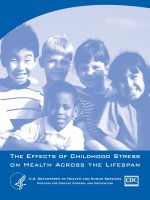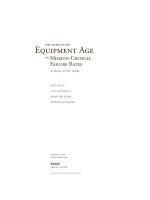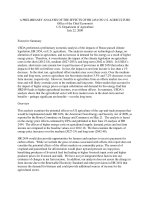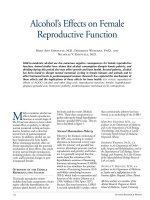The Effects of Workplace Hazards on Female Reproductive Health pot
Bạn đang xem bản rút gọn của tài liệu. Xem và tải ngay bản đầy đủ của tài liệu tại đây (295.69 KB, 23 trang )
The Effects of
Workplace
Hazards on Female
Reproductive
Health
National Institute for Occupational Safety and Health
DISCLAIMER
Mention of any company or product does not constitute en-
dorsement by the National Institute for Occupational Safety
and Health.
Copies of this and other NIOSH documents are available from
Publications Dissemination, EID
National Institute for Occupational Safety and Health
4676 Columbia Parkway
Cincinnati, OH 45226–1998
Fax number: (513) 533–8573
Telephone number: 1–800–35–NIOSH (1–800–356–4674)
E-mail:
To receive other information about occupational safety and
health problems, call 1–800–35–NIOSH (1–800–356–4674),
or visit the NIOSH Homepage on the World Wide Web at
/>DHHS (NIOSH) Publication No. 99–104
February 1999
This document is in the public domain and may be freely
copied or reprinted.
INTRODUCTION
Many factors can affect a woman’s reproductive
health and her ability to produce healthy children. We
know that the health of an unborn child can suffer if a
woman fails to eat right, smokes, or drinks alcohol
during pregnancy. However, we know very little
about the cause of most reproductive health problems
such as infertility, miscarriage, and birth defects. We
do know that some workplace hazards can affect a
woman’s reproductive health, her ability to become
pregnant, or the health of her unborn children.
This document answers the following questions:
What are reproductive hazards for female
workers?
How does the female reproductive system work?
What reproductive problems might be caused by
workplace exposures?
How are workers and their babies exposed?
How are families exposed?
How can exposures be prevented?
What additional information is available from
NIOSH?
1
INTRODUCTION
Many factors can affect a woman’s reproductive
health and her ability to produce healthy children. We
know that the health of an unborn child can suffer if a
woman fails to eat right, smokes, or drinks alcohol
during pregnancy. However, we know very little
about the cause of most reproductive health problems
such as infertility, miscarriage, and birth defects. We
do know that some workplace hazards can affect a
woman’s reproductive health, her ability to become
pregnant, or the health of her unborn children.
This document answers the following questions:
What are reproductive hazards for female
workers?
How does the female reproductive system work?
What reproductive problems might be caused by
workplace exposures?
How are workers and their babies exposed?
How are families exposed?
How can exposures be prevented?
What additional information is available from
NIOSH?
Substances or agents that affect the reproductive
health of women or men or the ability of couples to
have healthy children
are called reproductive
hazards. Radiation,
some chemicals, certain
drugs (legal and illegal),
cigarettes, some viruses,
and alcohol are exam-
ples of reproductive haz-
ards. This pamphlet
focuses on reproductive
hazards in the workplace
that affect women and
their ability to have
healthy children. For in-
formation about a pam-
phlet describing male
reproductive hazards, see page 18.
The harmful effects of a few agents found in the
workplace have been known for many years. For ex-
ample, more than 100 years ago, lead was discovered
to cause miscarriages, stillbirths, and infertility in
2
What are Reproductive Hazards for
Female Workers?
female pottery workers. Rubella (German measles)
was recognized as a major cause of birth defects in
the 1940s. However, the causes of most reproductive
health problems are still not known. Many of these
problems—infertility, miscarriage, low birth
weight—are fairly common occurrences and affect
working and nonworking women.
A reproductive hazard could cause one or more
health effects, depending on when the woman is ex-
posed. For example, exposure to harmful substances
during the first 3 months of pregnancy might cause a
birth defect or a miscarriage. During the last 6 months
of pregnancy, exposure to reproductive hazards could
slow the growth of the fetus, affect the development
of its brain, or cause premature labor. Reproductive
hazards may not affect every worker or every preg-
nancy.
Table 1 lists chemical and physical reproductive haz-
ards for women in the workplace. The list is not com-
plete and is constantly being revised. Therefore, do
not assume that a substance is safe if it is missing
from the list.
Table 2 lists viruses and other disease-causing (infec-
tious) agents that are found in some workplaces and
that have harmful reproductive effects in pregnant
women.
3
Table 1. Chemical and physical agents that are
reproductive hazards for women in the workplace
Agent Observed effects
Potentially
exposed workers
4
Table 2. Disease-causing agents that are reproductive
hazards for women in the workplace
Agent
Observed
effects
Potentially
exposed
workers
Preventive
measures
5
Workers with immunity through vaccinations or ear-
lier exposures are not generally at risk from diseases
such as hepatitis B, human parvovirus B19, German
measles, or chicken pox. But pregnant workers with-
out prior immunity should avoid contact with in-
fected children or adults.
Workers should also use good hygienic practices
such as frequent handwashing to prevent the spread
of infectious diseases among workers in elementary
schools, nursery schools, and daycare centers. In ad-
dition, they should use universal precautions—such
as glove wearing and safe disposal of needles—to
protect against disease-causing agents found in blood.
To understand how reproductive hazards can affect a
woman’s reproductive health and her ability to have
healthy children, it is helpful to understand how the
female reproductive system works.
The main reproductive tissues in women are the ova-
ries, uterus, and fallopian tubes. The functions of
these tissues are largely controlled by hormones
6
How Does the Female Reproductive
System Work?
produced by the brain and the pituitary gland. Hor-
mones are chemicals that are formed in the body and
circulate in the blood. These hormones regulate the
menstrual cycle, pregnancy, and the production of
breast milk. Estrogen and progesterone—the sex
hormones—are produced by the ovaries. These hor-
mones are responsible
for sexual develop-
ment and for prepar-
ing the uterine wall
to hold and nourish
a fertilized egg
every month. These
sex hormones also
contribute to the
basic health of the
heart, bones, liver,
and many other tis-
sues. Finally, during
pregnancy the
placenta produces a
hormone (human
chorionic gonado-
tropin, or hCG) that
signals the body to
support the preg-
nancy.
A woman is born with all of the eggs that she will
ever have. Therefore, if her eggs are damaged or
7
Uterus
Ovary
Fallopian tube
Pituitary gland
Brain
destroyed, she will not be able to replace them. At
puberty, a woman begins to have menstrual cycles,
which enable her to release an egg each month from
one of her ovaries. Each cycle begins with a few days
of menstrual flow. When each
new cycle begins, a new
egg starts to grow. Af-
ter 2 to 3 weeks, a
mature egg (ovum)
is released from the
ovary into the fallo-
pian tubes, where it
might be fertilized
by one of the many
sperm that may sur-
round it.
If the egg is not fertilized, it will die and leave the
body about 2 weeks later in the woman’s menstrual
flow. Then the process begins again with a new men-
strual cycle.
If the egg is fertilized, the complex process of repro-
duction continues. The fertilized egg travels for about
a week down the fallopian tube to reach the uterus,
where it attaches to the wall. A specialized tissue
called the placenta forms between the uterus and the
newly developing fetus. The placenta transfers oxy-
gen and nutrients from the mother to the fetus. Dur-
ing the first 3 months of pregnancy (first trimester),
8
the major fetal organs are formed. During the remain-
der of the pregnancy, these organs mature and the fe-
tus grows rapidly.
Only a few substances (some viruses, chemicals, and
drugs) are known to cause reproductive health prob-
lems. Scientists are just beginning to discover how
workplace exposures might cause reproductive prob-
lems. The following problems may be caused by
workplace exposures:
Menstrual cycle effects
Infertility and subfertility
Miscarriage and stillbirths
9
What Reproductive Hazards Might Be
Caused by Workplace Exposures?
Fallopian tube
Ovary
Placenta
Uterus
Fetus
Birth defects
Low birth weight and premature birth
Developmental disorders
Childhood cancer
Each problem is discussed in more detail in the fol-
lowing sections.
Menstrual Cycle Effects
High levels of physical or emotional stress or expo-
sure to chemicals such as carbon disulfide may dis-
rupt the balance between the brain, pituitary, and
ovaries. This disruption can result in an imbalance of
estrogen and progesterone, and lead to changes in
menstrual cycle length and regularity and ovulation.
Because these sex hormones have effects throughout
a woman’s body, severe or long-lasting hormone im-
balances may affect a woman’s overall health.
Infertility and Subfertility
About 10% to 15% of all couples are unable to con-
ceive a child after 1 year of trying to become preg-
nant. Many factors can affect fertility, and these
factors can affect one or both partners. Damage to the
woman’s eggs or the man’s sperm, or a change in the
hormones needed to regulate the normal menstrual
cycle are just a few things that can cause problems
with fertility.
10
Miscarriage and Stillbirths
About 1 in every 6 pregnancies ends in a miscar-
riage—the unplanned termination of a pregnancy.
Miscarriages can occur very early in pregnancy, even
before the woman knows she is pregnant. Miscar-
riages and stillbirths occur for many reasons, such as
the following:
The egg or sperm may be damaged so that the egg
cannot be fertilized or cannot survive after fertili-
zation.
A problem may exist in the hormone system
needed to maintain the pregnancy.
The fetus may not have developed normally.
Physical problems may exist with the uterus or
cervix.
What causes most of these problems is still unknown.
Birth Defects
A birth defect is a physical abnormality present at
birth, though it may not be detected until later. About
2% to 3% of babies are born with a major birth de-
fect. In most cases, the cause of the birth defect is un-
known. The first 3 months of the pregnancy is a very
sensitive time of development because the internal
organs and limbs are formed during this period.
11
Many women are not aware that they are pregnant
during much of this critical period.
Low Birth Weight and Premature Birth
About 7% of babies born in the United States are
born underweight or prematurely. Poor maternal nu-
trition, smoking, and alcohol use during pregnancy
are believed to be responsible for most of these cases.
Although better medical care has helped many under-
weight or premature babies to develop and grow
normally, they are more likely than other babies to
become ill or even die during their first year of life.
Developmental Disorders
Sometimes the brain of the fetus does not develop
normally, which leads to developmental delays or
learning disabilities later in life. About 10% of chil-
dren in the United States have some form of develop-
mental disability. Such problems are often not
noticeable at birth. They can be difficult to measure,
may be temporary or permanent, and range from
mild to severe. Developmental problems may appear
as hyperactivity, short attention span, reduced learn-
ing ability, or (in severe cases) mental retardation.
Childhood Cancer
Ionizing radiation has caused cancer in some children
whose mothers were exposed during pregnancy. The
12
current practice of minimizing the use of X-rays on
pregnant women, the use of newer equipment that re-
duces the risk of exposure, and the use of protective
shields have all helped to decrease the likelihood of
harmful radiation exposure to fetuses.
Harmful substances can enter a woman’s body
through
breathing in (inhalation),
contact with the skin,
or swallowing (ingestion).
Pregnant workers and those planning to become preg-
nant should be especially concerned about exposure
to reproductive hazards. Some chemicals (such as al-
cohol) can circulate in the mother’s blood, pass
through the placenta, and reach the developing fetus.
Other hazardous agents can affect the overall health
of the woman and reduce the delivery of nutrients to
the fetus. Radiation can pass directly through the
mother’s body to harm her eggs or the fetus. Some
drugs and chemicals can also pass through a mother’s
13
How Are Workers and
Their Babies Exposed?
body into the nursing baby through the breast milk.
However, breast feeding has many positive effects.
Thus a woman who may be exposed to reproductive
hazards on the job should consult with her doctor or
other health care provider before deciding whether or
not to breast feed.
Reproductive hazards do not affect every woman or
every pregnancy. Whether a woman or her baby is
harmed depends on how much of the hazard they are
exposed to, when they are exposed, how long they are
exposed, and how they are exposed.
14
Radiation
Viruses
drugs
chemicals
alcohol
Harmful agents in
mother’s blood
Reduced
health
of mother
Reduced supply of
nutrients and oxygen
Workplace substances that affect female workers and
their pregnancies can also harm
their families. Without knowing
it, workers can bring home
harmful substances that can
affect the health of other
family members—both
adults and children. For
example, lead brought
home from the workplace
on a worker’s skin, hair,
clothes, shoes, tool box, or
car can cause lead poisoning
in family members, espe-
cially young children.
Employers are responsible for training and protecting
their workers. Employees are responsible for learning
15
How Are Families Exposed?
How Can Exposures Be Prevented?
about the hazards in their workplace, using personal
protective equipment, and following proper work
practices. Since little is known about reproductive
hazards in the workplace, workers should also take
the following steps to ensure their own safety:
Store chemicals in sealed containers when they
are not in use.
Wash hands after contact with hazardous
substances and before eating, drinking, or
smoking.
Avoid skin contact with chemicals.
If chemicals contact the skin, follow the di-
rections for washing in the material safety data
sheet (MSDS). Employers are required to have
copies of MSDSs for all hazardous materials
used in their workplaces and to provide them to
workers upon request.
Review all MSDSs to become familiar with any
reproductive hazards used in your workplace. If
you are concerned about reproductive hazards in
the workplace, consult your doctor or health care
provider.
16
Participate in all safety and health education, train-
ing, and monitoring programs offered by your
employer.
Learn about proper work practices and engineer-
ing controls (such as improved ventilation).
Use personal protective equipment (gloves, respi-
rators, and personal protective clothing) to reduce
exposures to workplace hazards.
Follow your employer’s safety and health work
practices and procedures to prevent exposures to
reproductive hazards.
Prevent home contamination with the following
steps:
—
Change out of contaminated clothing and wash
with soap and water before going home.
—
Store street clothes in a separate area of the
workplace to prevent contamination.
—
Wash work clothing separately from other
laundry (at work if possible).
—
Avoid bringing contaminated clothing or other
objects home. If work clothes must be brought
home, transport them in a sealed plastic bag.
17
NIOSH has published the following documents that
contain information about reproductive hazards in the
workplace:
National Occupational Research Agenda—
DHHS (NIOSH) Publication No. 96–115
Reproductive issues are an important part of the
National Occupational Research Agenda that is be-
ing coordinated by NIOSH. The Agenda is expected
to help focus attention on reproductive issues and to
increase the amount of research conducted in this
critical area. This document discusses fertility and
pregnancy abnormalities as one of 21 priority re-
search areas.
The Effects of Workplace Hazards on Male
Reproductive Health—DHHS (NIOSH)
Publication No. 96–132
This document provides general information about
reproductive hazards for men in the workplace. The
text explains how substances in the workplace can
cause reproductive problems and suggests methods
for preventing exposures.
18
What Additional Information is
Available from NIOSH?
19
Notes
20
Notes
IOSH
DeliveringontheNation''spromise:
Safetyandhealthatwork
forallpeople
throughresearchandprevention
Toreceiveotherinformationaboutoccupationalsafetyandhealthproblems,call
,
visittheNIOSHHomepageontheWorldWideWebat
1–800–35–NIOSH (1–800–356–4674) or
/>DHHS(NIOSH)PublicationNo.99104−
D
E
P
A
R
T
M
E
N
T
O
F
H
E
A
L
T
H
&
H
U
M
A
N
S
E
R
V
I
C
E
S
U
S
A
D
E
P
A
R
T
M
E
N
T
O
F
H
E
A
L
T
H
&
H
U
M
A
N
S
E
R
V
I
C
E
S
U
S
A
U.S.DEPARTMENTOFHEALTHANDHUMANSERVICES
PublicHealthService
CentersforDiseaseControlandPrevention
PublicHealthService
CentersforDiseaseControlandPrevention
NationalInstituteforOccupationalSafetyandHealth
CDC
CENTERSFORDISEASECONTROL
ANDPREVENTION
CENTERSFORDISEASECONTROL
ANDPREVENTION









